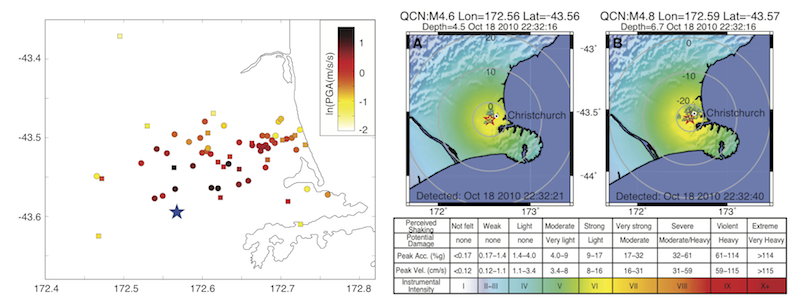2012 IRIS Workshop
Ground Motion Estimates and Rapid Earthquake Detection Using the Quake-Catcher Network
Elizabeth S. Cochran: U.S. Geological Survey, Jesse F. Lawrence: Stanford University, Angela Chung: Stanford University, Anna Kaiser: GNS Science, Bill Fry: GNS Science, John Evans: U.S. Geological Su
M5.1 aftershock near Christchurch New Zealand. (Left) Peak ground accelerations recorded by QCN (circles) and GeoNet (squares) sensors. (Right) Initial (A) and final (B) earthquake location and magnitude estimated by the QCN network.

Full-resolution graphics file in original format: 0029.jpg
Low-cost micro-electro-mechanical systems (MEMS) accelerometers have improved rapidly allowing for very dense seismic arrays. The Quake-Catcher Network (QCN) makes use of MEMS-based tri-axial sensors installed in homes and businesses to record earthquakes, with 3000 participants worldwide. We compare the instrumental sensitivity between traditional and MEMS-based sensors by conducting shake table tests of five different types of MEMS sensors. Overall, sensors performed to expectations. We also compare seismograms recorded following the 3 September 2010 Mw7.1 Darfield earthquake by 192 QCN stations that were installed in a dense array to record the on-going aftershock sequence in and around the city of Christchurch. The peak ground accelerations (PGA) recorded during a M5.1 aftershock are spatially variable, but show a clear decay in amplitude with distance. In general, closely located GeoNet and QCN stations report similar PGA. Finally, data are used to test the real-time rapid earthquake detection scheme. We find the network can provide reasonable estimates of the earthquake location and magnitude within 8-12 seconds, on average.
Acknoweldgements: Work presented here is supported by the National Science Foundation.
For further reading: Cochran, E.S., J.F. Lawrence, A. Kaiser, B. Fry, A. Chung, C. Christensen, Comparison between low-cost and traditional MEMS accelerometers: a case study from the M7.1 Darfield, New Zealand aftershock deployment, Annals of Geophysics, 54(6), 728-732, 2011. doi: 10.4401/ag-5268
Keywords: rapid_earthquake_detection, seismic_instrumentation, large_n_networks
